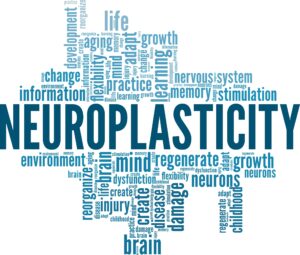Eye Movement Desensitization and Reprocessing (EMDR) is a therapy that has received significant attention for its effectiveness in treating trauma, as well as depression, anxiety, grief and loss, and addiction in more recent years. A critical component of EMDR’s success lies in its ability to harness the brain’s neuroplasticity—the capacity of the brain to change by forming new neural connections. In other words, the negative things you feel and believe about yourself now, doesn’t have to be your life. This blog post delves into the relationship between EMDR and neuroplasticity, highlighting specific research that demonstrates how EMDR can rewire the brain and facilitate healing.
Understanding Neuroplasticity
Neuroplasticity refers to the brain’s ability to adapt and change in response to experiences, learning, and environmental influences. This dynamic process enables the brain to recover from injuries, adapt to new situations, and even overcome psychological trauma. When a person experiences trauma, the brain can become “stuck” in a painful state, leading to symptoms such as depression, anxiety, feeling on edge, bouts of anger, and a pronounced startle response. Neuroplasticity allows the brain to “unlearn” these unwanted responses and replace them with more life-giving patterns of thinking and behavior. After just a few sessions of EMDR, most people report feeling more grounded, anchored, and calm. Most people report sleeping better, feeling less anxious and stressed, and more present in their lives and relationships. Such generally rapid results reflect the amazing effects of the brain’s ability to change itself through the rewiring of neuroplasiticity: the unwanted aspects of life you experience now, doesn’t have to be your “forever.”
EMDR and the Brain’s Healing Process
EMDR therapy involves the use of bilateral stimulation, typically through guided eye movements. Decades of evidence strongly suggest that the utilization of the eye movements or tapping unique to EMDR remain responsible for EMDR remaining a generally more effective treatment for stress, anxiety, anger, and depression than other more traditional “talk” therapies. During an EMDR session, the therapist guides the client to recall distressing memories while simultaneously engaging in bilateral stimulation. Research indicates this process enhances communication between the brain’s hemispheres, promoting the integration and processing of distressing memories or future fears and anxieties.
Research supports EMDR as leveraging neuroplasticity to rewire the brain. A study by Pagani (2012) used electroencephalography (EEG) to examine brain activity in patients with histories of stress and trauma before and after EMDR therapy. The results showed significant positive changes in brain wave patterns, indicating that EMDR facilitated the processing of painful memories and reducing the hyper-arousal associated with PTSD or anxiety.
Research Supporting EMDR as Positively Rewiring Neural Pathways in the Brain:
Several studies have demonstrated the impact of EMDR on brain function and structure, highlighting its role in promoting neuroplasticity:
1. **Pagani et al. (2015)**: This study used functional magnetic resonance imaging (fMRI) to observe brain activity in PTSD patients undergoing EMDR. The findings revealed that EMDR led to decreased activation in the amygdala (responsible for fear and anxiety responses) and increased activation in the prefrontal cortex (associated with attention, working memory, and rational thinking). These positive changes strongly suggest that EMDR helps the brain reprocess distressing memories and sources of anxiety, reducing their unwanted emotional impact.
2. **Levin et al. (1999)**: This research demonstrated that EMDR can positively alter the neural networks involved in memory processing. The study showed that EMDR increased connectivity between the hippocampus (involved in memory formation) and other brain regions, facilitating the integration of traumatic memories into a coherent narrative. This process is crucial for reducing the intrusive symptoms characteristic of PTSD, depression, or anxiety.
3. **Bossini et al. (2011)**: Using single-photon emission computed tomography (SPECT), this study observed positive changes in the brain perfusion (the movement of blood from the brain to other essential organs) following EMDR therapy. The results indicated that EMDR led to normalized blood flow in the limbic system, a region involved in emotional regulation. These findings support the idea that EMDR promotes neuroplasticity by restoring balance to brain regions disrupted by stress or trauma.
Conclusion
EMDR leverages the brain’s inherent neuroplasticity to positively change unwanted, conditioned ways of thinking or being. Research has shown that EMDR can lead to significant positive changes in brain function and structure, facilitating the processing and and reduced stress of distressing memories or anxieties. By harnessing neuroplasticity, EMDR offers a powerful tool for improving quality of life.
References:
1. Pagani, M., et al. (2012). Neurobiological correlates of EMDR monitoring – An EEG study. *PLOS ONE*.
4. Bossini, L., et al. (2011). Changes in cerebral blood flow in PTSD patients after EMDR treatment: A SPECT study. *European Review for Medical and Pharmacological Sciences*.


